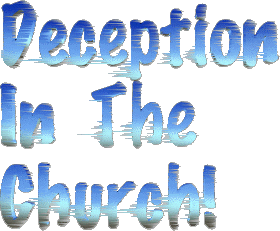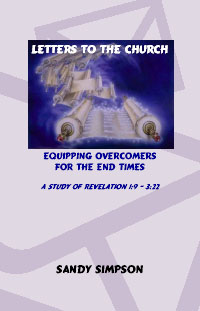
e-Newsletter
Volume Nine, Issue Ten
7/03
Volume 9, Issue 9
"DECEPTION IN THE CHURCH" e-Newsletter
7/03
Dear DITC E-Newsletter subscribers,
Praise the Lord Jesus Christ for His continual grace and mercy toward
us!
A lot is happening at DITC this month.
NEW! PERSONALIZED
RESEARCH PAGE
Ever been frustrated with just how big DITC has become when you are
trying to find an article? Ever wanted a list of the best articles
fast on one page sent directly to your email box? Just don't want
to hassle with searching for articles on a given subject or person?
These are some of the reasons we are now offering a new Personalized
Research option. For $10.00 we will send you information on
any subject or individual listed on the PR page. We will send you
a list of all the best articles with the links to get there. We do
all the footwork for you. Check it out!
NEW! BOOK
REVIEWS PAGE
Check out our new Book
Reviews page on DITC. It is an alphabetical directory of
book, video, newsletter and course reviews by title. This is a handy
research guide of reviews by the best apologist authors.
FEATURE ARTICLE
The feature article in this newsletter is "Tares
(Darnel)" by Ed Tarkowski, STAND & COMFORT Newsletter, #44
(Vol 3 No 11). This is an amazing, eye opening article on what Jesus
was referring to when He taught about tares. What is a "tare"?
You will be amazed to discover what a tare is and its properties.
Excellent Resources!
 |
Timely!
LETTERS TO THE CHURCH is a fitting
manual for the Revelation Christian. All the precepts are in the seven
letters in Revelation 1:9 - 3:22 to help us keep the faith, stay in sound
doctrine, and reach out to those who are perishing. I hope and pray that
this book will help the reader to be an “overcomer”.
Go here
for more details and how to order!
|
 |
Demolish Arguments!
Want to be able to see your way through to clear biblical discernment?
Want a set of tools that will allow you to disciple your loved ones so
they will stand firm in the Faith? Want to sort out many of the false arguments
and teachings that have invaded the churches? Then
DISCERNMENT
TOOLKIT is for you!
Go here
for more details and how to order!
|
 |
Important Video Information
On Benny Hinn!
SPIRIT OF TRUTH OR SPIRIT OF ERROR?
PART 1 - BENNY HINN
features Jacob Prasch, Mike Oppenheimer &
Sandy Simpson and tons of video showing the teachings and prophecies of
Benny Hinn. This is a proven tool to keep people away from heresy.
Go here
for more details and how to order!
|
In His hands,
Sandy Simpson
Apologetics Coordination Team (ACT)
Tares (Darnel)
by Ed Tarkowski
STAND & COMFORT Newsletter
Email NEWSLETTER #44 (Vol 3 No 11)
A friend recently wrote to me about how prolific her garden was, but
that the weeds were prospering as well. She said that because of the rains,
the weeds would be easy to pull up. I thought how when we allow the rain
of God's word into our life, the lies, untruths and deceptions are also
easy to weed out. But if the word is not given its place of priority, then
when those evils take root and the ground hardens, how hard it is to pull
up the weeds! Have you ever tried to pull a weed out of a dry, caked, hardened
piece of ground? What usually happens is you pull off the green foliage
above the soil, but the root remains, only to quickly grow up again. Notice
the word "quickly." Weeds don't grow slowly. But the trick in pulling them
up successfully is to soak the ground with water, soften the soil and then
weed-pulling becomes a pleasure again. I remember when I was a boy and
I had to weed my Dad's garden. The tops of the weeds would come off and
I would say to myself, "Oh, well, at least it LOOKS LIKE I got that weed
out. Dad won't know," and I would leave it, being satisfied with that.
In the spiritual realm, apathy towards the weeds in our life is just as
deadly to us as the real weeds are to the future fruit of a vegetable garden.
Water, or the word of God, plays a crucial part in both the natural realm
and the spiritual in staying weed-free.
Jesus told the parable of the tares and the wheat in Matthew 13:24-30.
The tares are a weed plant, but Jesus didn't say to pull up the tares.
He said to let the wheat and the tares grow up together and the angels
would deal with the tares at the end of the age. I sure would have liked
to apply that to my Dad's idea of weeding. The difference between the garden
I weeded and
the wheat field Jesus spoke of is this: my garden was vegetables, planted
and grown in rows with dirt paths between. The weeds were easy to get to
and pulling them without harming the good plants was easy enough. Wheat
is grown in fields, each sheaf next to another with no paths, creating
a carpet effect when looked at from a distance. Pulling up the tares in
this situation would endanger the wheat stocks as well. You just don't
weed wheat.
Jesus said,
Mat 13:24 Another parable put he forth unto them, saying, The
kingdom of heaven is likened unto a man which sowed good seed in his field:
25 But while men slept, his enemy came and sowed tares among
the wheat, and went his way.
26 But when the blade was sprung up, and brought forth fruit,
then appeared the tares also.
27 So the servants of the householder came and said unto him,
Sir, didst not thou sow good seed in thy field? from whence then hath it
tares?
28 He said unto them, An enemy hath done this. The servants said
unto him, Wilt thou then that we go and gather them up?
29 But he said, Nay; lest while ye gather up the tares, ye root
up also the wheat with them.
30 Let both grow together until the harvest: and in the time
of harvest I will say to the reapers, Gather ye together first the tares,
and bind them in bundles to burn them: but gather the wheat into my barn.
Holman's Bible Dictionary defines TARES as follows:
"TARES KJV term for grassy weeds resembling wheat, generally identified
as darnel (genus Lolium)"
It is pretty much accepted today that the tares Jesus spoke of are darnel
of the genus Lolium. Cephalaria syriaca is also a possibility mentioned
by some researchers, but based on archeological studies, its evident lack
in Biblical times would seem to indicate it is not the tare of the Bible.
Secular dictionaries also define the tare as most likely being darnel:
"Darnel is a weed grass (probably bearded darnel or Lolium temulentum)
that looks very much like wheat until it is mature, when the seeds reveal
a great difference. Darnel seeds aren't good for much except as chicken
feed or to burn to prevent the spread of this weed" (World English Dictionary).
Easton's Bible Dictionary describes "tares" as follows:
"the bearded darnel, mentioned only in Matt. 13:25-30. It is the Lolium
temulentum, a species of rye-grass, the seeds of which are a strong soporific
poison. It bears the closest resemblance to wheat till the ear appears,
and only then the difference is discovered. It grows plentifully in Syria
and Palestine."
The American Heritage® Dictionary of the English Language: Fourth
Edition 2000 defines "soporific: as:
ADJECTIVE: 1. Inducing or tending to induce sleep. 2. Drowsy.
NOUN: A drug or other substance that induces sleep; a hypnotic.
Smith's Bible Dictionary offers these comments on the "tares":
"There can be little doubt that the zizania of the parable, #Mt 13:25
denotes the weed called "darnel" (Lolium temulentum). . . . The grains
of the L. temulentum, if eaten, produce convulsions, and even death."
A very interesting note I found on Botanical.com concerning darnel was
this:
"The admixture of the grain with those of the nutritious cereals amongst
which it is often found growing should be guarded against, as its properties
are generally regarded as deleterious. Gerard tells us: 'the new bread
wherein Darnel is eaten hot causeth drunkenness.' When Darnel has been
given medicinally in a harmful quantity, it is recorded to have produced
all the symptoms of drunkenness: a general trembling, followed by inability
to walk, hindered speech and vomiting. For this reason the French call
Darnel: 'Ivraie,' from Ivre (drunkenness); the word Darnel is itself of
French origin and testifies to its intoxicating qualities, being derived
from an old French word Darne, signifying stupefied. The ancients supposed
it to cause blindness, hence with the Romans, lolio victitare, to live
on Darnel, was a phrase applied to a dim-sighted person.
"The alleged poisonous properties of Darnel are now generally believed
to be due to a fungus" (http://www.botanical.com/botanical/mgmh/g/grasse34.html#dar).
Interesting also is the fact that farmers in the modern wheatbelt of
America have to take measures to control the effects of tares (in this
case, lolium rigidum) on their cattle due to bacteria (ARGT, Annual Ryegrass
Toxicity). In a 30 year study, 250,000 sheep and 600 cattle died because
of ARGT, not to mention the effects of intoxification on a score of others.
(See
http://216.239.33.100/search?q=cache:Qc2U93vTB2YJ:www.agric.wa.gov.au/cropupdates/2002/Farm_systems/article12.pdf+%2Bcattle+%2Blolium+%2Bintoxicated&hl=en&ie=UTF-8).
Recapping the symptoms in the various definitions above concerning darnel
and/or its fungus, they are:
1. Sleepiness, drowsiness
2. Hypnotic episodes
3. Convulsions
4. Drunkenness, intoxication
5. Trembling
6. Inability to walk
7. Hindered speech
8. Vomiting
9. Stupification
10. Dim-sightedness
Other sites I visited include giddiness, apathy and various abnormal
sensations as effects of darnel.
In the early days of "the move of God," we saw all of these things and
they are still happening today. Not only is there darnel in the Church,
the darnel has apparently been affected by fungus. Not only that, but one
must wonder how many cases of spiritual blindness and death have occurred.
Some say darnel in itself is not harmful, often being used for hay for
livestock. They say that it's when the parasite fungus takes up residence
within the seed head that it becomes deadly in the physical realm. But,
in Jesus' parable, the analogy does not hold water. Spiritually, darnel
has the destiny of being cast into the fire. Wheat is to be gathered into
the barn. It may not appear that spiritual darnel is that dangerous, but
when one looks at the end result, it is deadly:
30 Let both grow together until the harvest: and in the time of
harvest I will say to the reapers, Gather ye together first the tares,
and bind them in bundles to burn them: but gather the wheat into my barn.
There is a time to distinguish between darnel and wheat. The fruit of
the darnel is smaller than the fruit produced by true wheat. They say the
difference is very distinguishable and obvious, and the difference in the
sizes of the seeds makes separating them an easy task. There are those
who have convulsed, been made drunk, trembled uncontrollably, stammered
in their speech, were stupified, turned giddy, etc., who have tried to
tell us that that was wheat. There are also those who have not fallen into
such things, but have brought confusion into the Church with darnel such
as the non-trinitarian doctrine, a watered-down gospel, and agendas that
lead the Church off into corporate efforts God never sanctioned. Are these
things wheat or darnel? Some are obviously darnel, while with others, it
takes time to make the distinction. This I know for sure: the One who planted
the good seed which bears fruit will come back to harvest His wheat, and
not one grain of darnel will be found in the barn.

